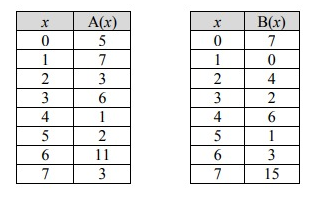FINDING COMPOSITION OF FUNCTION FROM GIVEN ORDERED PAIRS
Subscribe to our ▶️ YouTube channel 🔴 for the latest videos, updates, and tips.
In the given set of ordered pairs, which is in the form of
(x, y)
the first value is input and second value is the output.
Problem 1 :
Given the function
f = {(-3, 4), (-2, 2), (-1, 0), (0, 1), (1, 3), (2, 4), (3, -1)}
and the function
g = {(-3, -2), (-2, 0), (-1, -4), (0, 0), (1, -3), (2, 1), (3, 2)},
compute the following values.
a) (f ∘ g)(3)
b) (f ∘ f)(0)
c) (g ∘ f)(3)
d) (g ∘ g)(-2)
e) (g ∘ f ∘ g)(0)
f) f(f(f(f(f(1)))))
Solution:
a)
(f ∘ g)(3) = f(g(3))
When 3 is the input, calculating the value of the function g, we get
f(g(3)) = f[2]
When the input is 2, the value of the function f, we get
= 4
b)
(f ∘ f)(0) = f(f(0))
When 0 is the input, calculating the value of the function f, we get
f(f(0)) = f[1]
When the input is 1, the value of the function f, we get
= 3
c)
(g ∘ f)(3) = g(f(3))
When 3 is the input, calculating the value of the function f, we get
g(f(3)) = g[-1]
When the input is -1, the value of the function g, we get
= -4
d)
(g ∘ g)(-2) = g(g(-2))
When -2 is the input, calculating the value of the function g, we get
g(g(-2)) = g[0]
When the input is 0, the value of the function g, we get
= 0
e)
(g ∘ f ∘ g)(0) = g(f(g(0)))
= g(f(0))
= g(1)
= -3
f)
f(f(f(f(f(1))))) = f(f(f(f(3))))
= f(f(f(-1)))
= f(f(0))
= f(1)
= 3
Problem 2 :
The functions A(x) and B(x) are defined by the tables below.

a) A(B(4))
b) B(A(1))
c) B(A(7))
d) A(B(1))
Solution:
a)
A(B(4))
When 4 is the input, calculating the value of the function B, we get
A(B(4)) = A[6]
When the input is 6, the value of the function A, we get
= 11
b)
B(A(1))
When 1 is the input, calculating the value of the function A, we get
B(A(1)) = B[7]
When the input is 7, the value of the function B, we get
= 15
c)
B(A(7))
When 7 is the input, calculating the value of the function A, we get
B(A(7)) = B[3]
When the input is 3, the value of the function B, we get
= 2
d)
A(B(1))
When 1 is the input, calculating the value of the function B, we get
A(B(1)) = A[0]
When the input is 0, the value of the function A, we get
= 5
Problem 3 :
For f = {(1, 2), (3, 3), (2, 4), (4, 1)} and g = {(1, 3), (3, 4), (2, 2), (4, 1)}, find f ∘ g and g ∘ f if they exist.
Solution:
f[g(1)] = f(3) = 3
f[g(2)] = f(2) = 4
f[g(3)] = f(4) = 1
f[g(4)] = f(1) = 2
f ∘ g = {(1, 3), (2, 4), (3, 1), (4, 2)}
g[f(1)] = g(2) = 2
g[f(2)] = g(4) = 1
g[f(3)] = g(3) = 4
g[f(4)] = g(1) = 3
g ∘ f = {(1, 2), (2, 1), (3, 4), (4, 3)}
Subscribe to our ▶️ YouTube channel 🔴 for the latest videos, updates, and tips.
Recent Articles
-
Finding Range of Values Inequality Problems
May 21, 24 08:51 PM
Finding Range of Values Inequality Problems -
Solving Two Step Inequality Word Problems
May 21, 24 08:51 AM
Solving Two Step Inequality Word Problems -
Exponential Function Context and Data Modeling
May 20, 24 10:45 PM
Exponential Function Context and Data Modeling